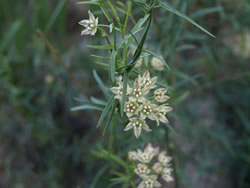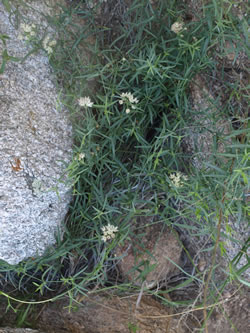Climbing Milkweed (Funastrum cynanchoides var. hartwegii)
 Funastrum cynanchoides var. hartwegiirange map. USDA PLANTS Database.
Funastrum cynanchoides var. hartwegiirange map. USDA PLANTS Database.
Vines dominate the Sky Islands during the rainy season. There are many members of the Apocynaceae that bloom in the mountains. Everyone is familiar with the common milkweeds (Ascelpias), but there are many other interesting species in this family. The climbing milkweed grows over other plants and rocks in canyons and washes. It is often intermixed with morning glories to form colorful assemblages in the summer.
Climbing milkweed has opposite leaves that are most often linear, sometimes sagittate (shaped like an arrowhead). The stems contain milky sap, and the plant has a disagreeable odor.
It produces many flowers in dense heads (umbels). The flowers are pink or white. Blooming is associated with summer rains, lasting until October. It is a perennial vine, dying back in the winter. Milkweeds are a favorite nectar source for butterflies.
The plant produces follicles (tear-shaped fruits) filled with silky white hairs with seeds attached. The seeds are dispersed by the wind once the follicles split open.
Green fruits are edible, and the Tohono O’odham are thought to have eaten the fruits of this species. Climbing milkweed is found throughout Arizona, southern New Mexico and Texas, and California.



